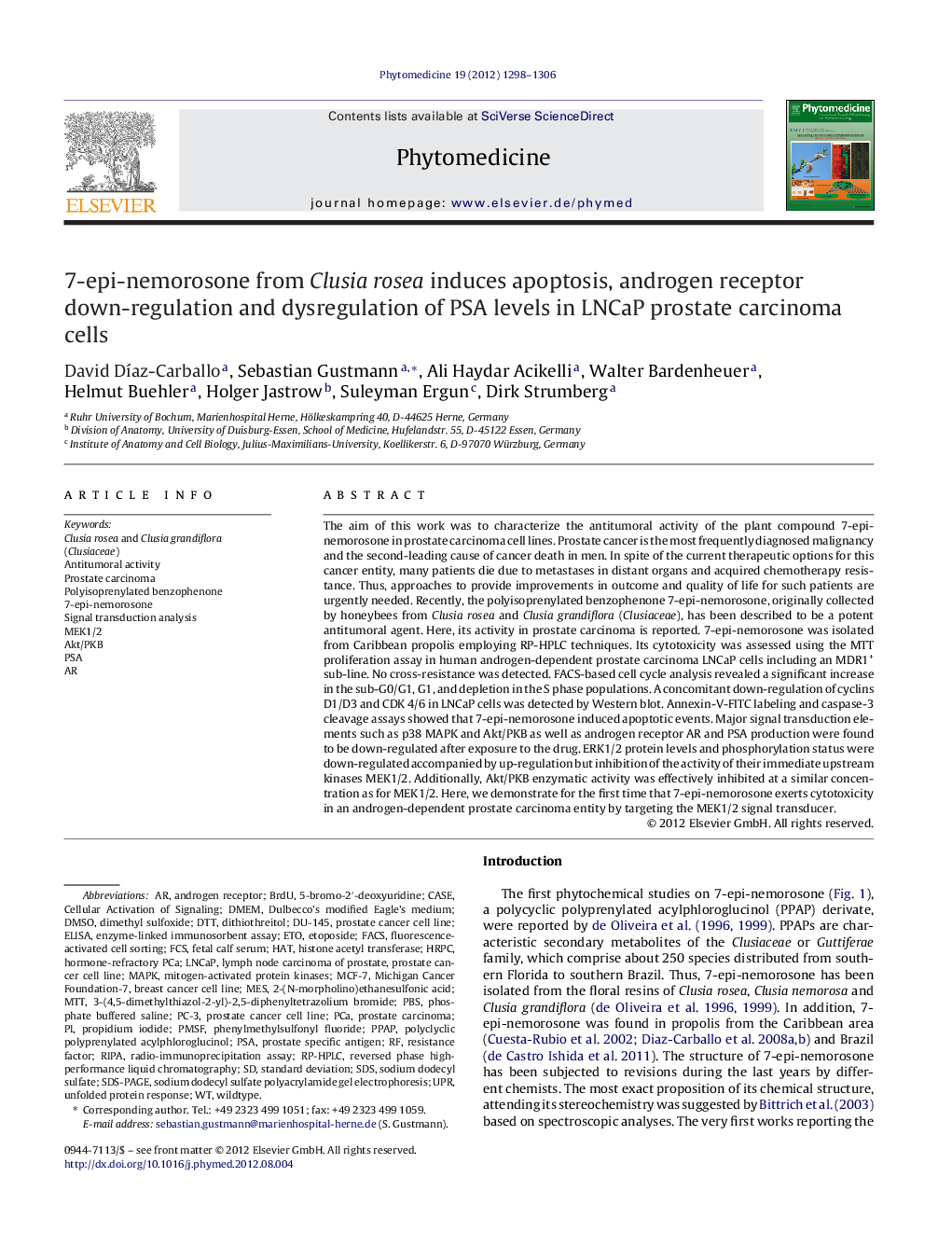| Article ID | Journal | Published Year | Pages | File Type |
|---|---|---|---|---|
| 5816782 | Phytomedicine | 2012 | 9 Pages |
Abstract
The aim of this work was to characterize the antitumoral activity of the plant compound 7-epi-nemorosone in prostate carcinoma cell lines. Prostate cancer is the most frequently diagnosed malignancy and the second-leading cause of cancer death in men. In spite of the current therapeutic options for this cancer entity, many patients die due to metastases in distant organs and acquired chemotherapy resistance. Thus, approaches to provide improvements in outcome and quality of life for such patients are urgently needed. Recently, the polyisoprenylated benzophenone 7-epi-nemorosone, originally collected by honeybees from Clusia rosea and Clusia grandiflora (Clusiaceae), has been described to be a potent antitumoral agent. Here, its activity in prostate carcinoma is reported. 7-epi-nemorosone was isolated from Caribbean propolis employing RP-HPLC techniques. Its cytotoxicity was assessed using the MTT proliferation assay in human androgen-dependent prostate carcinoma LNCaP cells including an MDR1+ sub-line. No cross-resistance was detected. FACS-based cell cycle analysis revealed a significant increase in the sub-G0/G1, G1, and depletion in the S phase populations. A concomitant down-regulation of cyclins D1/D3 and CDK 4/6 in LNCaP cells was detected by Western blot. Annexin-V-FITC labeling and caspase-3 cleavage assays showed that 7-epi-nemorosone induced apoptotic events. Major signal transduction elements such as p38 MAPK and Akt/PKB as well as androgen receptor AR and PSA production were found to be down-regulated after exposure to the drug. ERK1/2 protein levels and phosphorylation status were down-regulated accompanied by up-regulation but inhibition of the activity of their immediate upstream kinases MEK1/2. Additionally, Akt/PKB enzymatic activity was effectively inhibited at a similar concentration as for MEK1/2. Here, we demonstrate for the first time that 7-epi-nemorosone exerts cytotoxicity in an androgen-dependent prostate carcinoma entity by targeting the MEK1/2 signal transducer.
Keywords
SDSDTTMCF-7EToRP-HPLCPMSFPSAFCSRIPAUPRHRPCDMEMLNCaPDU-145PC-3FACSPPAPPBSPolyisoprenylated Benzophenone2-(N-morpholino)ethanesulfonic acid3-(4,5-dimethylthiazol-2-yl)-2,5-diphenyltetrazolium bromide5-bromo-2′-deoxyuridineDMSOMAPKDulbecco's modified Eagle's mediumMEK1/2MTTPCAradio-immunoprecipitation assayProstate specific antigenAkt/PKBEtoposideSDS-PAGESodium dodecyl sulfate polyacrylamide gel electrophoresisstandard deviationBrdUELISAEnzyme-linked immunosorbent assayfluorescence-activated cell sortingdithiothreitolDimethyl sulfoxidesodium dodecyl sulfateProstate carcinomafetal calf serumResistance factorPhosphate buffered salineAntitumoral activityphenylmethylsulfonyl fluorideMeSCASEwildtypehistone acetyl transferaseUnfolded protein responsePropidium iodideReversed phase high-performance liquid chromatographyHATmitogen-activated protein kinasesAndrogen Receptor
Related Topics
Life Sciences
Biochemistry, Genetics and Molecular Biology
Clinical Biochemistry
Authors
David DÃaz-Carballo, Sebastian Gustmann, Ali Haydar Acikelli, Walter Bardenheuer, Helmut Buehler, Holger Jastrow, Suleyman Ergun, Dirk Strumberg,
